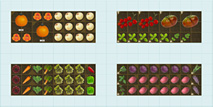How to grow Rhubarb?
- Latin Family: Polygonaceae
- Latin Genus: Rheum
- Ease of Growing: Easy
- Growing Type: Perennial
It has fallen from grace in the past 50 years or so and is now becoming relatively unusual. It is quite an acquired taste, but many people come to love it.
Videos
Rhubarb History
Rhubarb was first grown in gardens for medicinal purposes, but then began to be eaten as a food. It became popular in Northern Europe as a fruit substitute for desserts. Presumably this only happened after cheap sugar became available to sweeten it, as it is very sour. It was popular because it can be harvested early in the year, before any real fruit is available.
Soil Preference
- PH (min/max): 5.0 - 6.8
- PH Ideal (min/max): 5.5 - 6.5
Rhubarb is a heavy feeder and prefers a deep, rich, moisture retentive soil with lots of organic matter. It is a perennial and will be in the ground for a long time, so you should incorporate lots of organic matter into the soil before planting. You might even double dig to get some of that organic matter down deep. The soil needs to be well-drained, otherwise the roots may rot over the winter.
How to care for Rhubarb?
Rhubarb is a very independent plant and needs relatively little care.
Rhubarb is in the ground for a long time, so choose a site where it won’t be disturbed. It should be well away from shrubs or trees, whose roots might take nutrients away from it.
Plants should be divided every 4 or 5 years, to prevent overcrowding. Divide the roots to leave at least one, and preferably two, buds on each piece of root.
Water
Keep the soil evenly moist, but not wet. Don't let the soil become soggy, as crown rot may occur.
Fertilizer
Rhubarb prefers a deep, rich, fertile soil because it's a fairly hungry plant.
Seeds
Seed Viability: 2 - 4 years
Rhubarb produces seed readily if you allow it to, in fact the usual problem is stopping it. It doesn’t often self-sow, but doesn’t need to because it is a long lived perennial.
Light
Sun: min. 6 hours daily
Full sun. When growing in cool climates Rhubarb needs a sunny site, where it won’t get too much frost (which could delay early harvests).
Conditions:Cold, Cool
Season:Short Season, Long Season
Part shade
Rhubarb can be grown in a less than ideal climate of hot dry summers and mild wet winters, and it still does surprisingly well. In this climate it does best with light shade, as the large leaves can lose a lot of water on a hot day. It also benefits from a cooler micro-climate.
Conditions:Warm, Hot
Season:Short Season, Long Season
Storage
Cut rhubarb stalks into chunks, 1" in size, and seal in an airtight bag. Frozen rhubarb will keep up to a year at 0˚ F.
Storage Req: Freezer
Storage Temp: 0-32°F
Storage Length: 1-360 days
Remove all leaves and store just the stalks in a plastic bag.
Storage Req: Refrigerator
Storage Temp: 35-40°F
Storage Length: 14-28 days
Problems
Gophers
One of rhubarb's biggest problems is Gophers. These rodents will completely destroy a plant, which is a problem in a plant that takes so long to grow. In Gopher country the best solution is to plant them in wire baskets.
Bolting
Any flower stalk that appears should be removed promptly to stop the plant devoting energy to seed production. If it does try to flower don’t let it produce seed, as this would waste even more energy.
Rhubarb Types
- Rhubarb
Rhubarb's tart flavor makes it great for making pies, jams, and jellies.
The foliage is poisonous and should never be eaten.
Pests
- Leafhoppers
- Leafminers
- Gophers
- Japanese Beetle
- Slugs and snails
- Tarnished Plant Bug
Diseases
- Gray Mold Botrytis Fruit Rot
- Anthracnose
- Crown Rot
- Damping Off
- Angular Leaf Spot
- Verticillium Wilt
